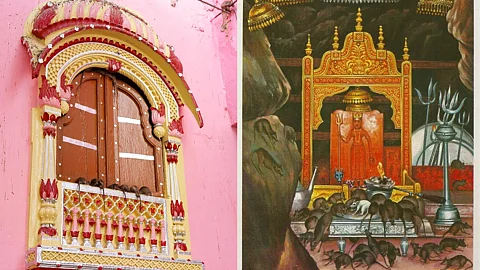
- HOMEGROWN WORLD
- #HGCREATORS
- #HGEXPLORE
- #HGVOICES
- #HGSHOP
- CAREERS
- ABOUT US
- CONTACT US

Tucked away in the quaint town of Deshnok, Rajasthan, the Karni Mata Temple is one of India’s most unique and surreal religious sites. Famous for housing over 25,000 rats, this temple presents an unusual blend of spiritual devotion and wildlife coexistence. Known locally as ‘Kabbas’, these rats are considered sacred.
The origins of the Karni Mata Temple are rooted in the life of Karni Mata, a mystic who lived in the 14th century. Venerated as an incarnation of the Goddess Durga, she was known for her ability to perform miracles. One such miracle involved her stepson Laxman, who tragically drowned. Devastated by his death, Karni Mata pleaded with Yama, the god of death, to bring him back. After much persistence, Yama allowed Laxman’s soul to return — but said that he would be reincarnated as a rat. From that moment, the rats at the temple were considered sacred incarnations of Karni Mata’s family and followers.
While the rats are undoubtedly the temple’s most unusual feature, the architecture of Karni Mata Temple is equally mesmerizing. Originally built in the 15th century, the structure was later expanded in the early 1900s by Maharaja Ganga Singh of Bikaner. The marble facade, intricate carvings, and silver-plated doors give it a blend of Rajput and Mughal architectural styles.
For devotees and curious travelers alike, the sight of thousands of rats scurrying freely within the temple is astonishing. Visitors often come bearing offerings of milk, grains, and sweets for the rats, considering it an act of devotion. Harming or killing a rat is considered sacrilegious and, if done accidentally, must be atoned for by donating a solid silver rat to the temple.
The presence of a rare white rat is an especially auspicious sight. With only a handful of these albino rats among the throngs of black and brown rodents, catching a glimpse of one is believed to bring good fortune. Visitors to the Karni Mata Temple can partake in a range of activities beyond rat-watching. Daily rituals like the aarti are a spectacle of devotion. Devotees offer prasad to the rats, believing that sharing food with these sacred creatures strengthens their connection to the divine.
The temple comes alive during the biannual Karni Mata Fair, held during the Navratri festival in March and October. During this time, the temple is adorned with oil lamps, and the atmosphere buzzes with festivities, including music, dance, and local art displays. Pilgrims from all over India flock to the temple. The fair also offers visitors a chance to immerse themselves in Rajasthani culture, with traditional performances and handicraft stalls lining the temple grounds.
The Karni Mata Temple represents a deeper understanding of how religion, culture, and nature intertwine. It challenges conventional perceptions of what is considered sacred, offering you a glimpse into India’s complex spiritual traditions. It also stands as a testament to the coexistence of humans and animals in a space of devotion. For those open to exploring the unusual, the temple offers an unforgettable experience that combines architectural beauty, rich mythology, and a somewhat unexpected form of spiritual connection.
